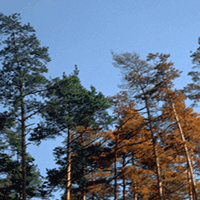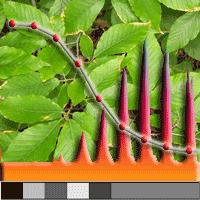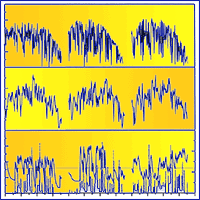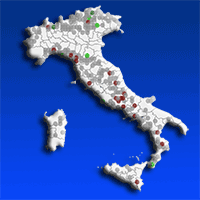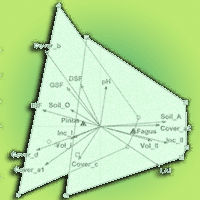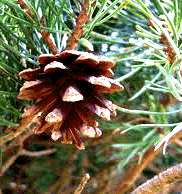
Drought-induced mortality of Scots pines at the southern limits of its distribution in Europe: causes and consequences
A Giuggiola (1) , TM Kuster (1), S Saha (2)
iForest - Biogeosciences and Forestry, Volume 3, Issue 4, Pages 95-97 (2010)
doi: https://doi.org/10.3832/ifor0542-003
Published: Jul 15, 2010 - Copyright © 2010 SISEF
Review Papers
Collection/Special Issue: NFZ Summer School 2009 - Birmensdorf (Switzerland)
Long-term ecosystem research: understanding the present to shape the future
Guest Editors: Marcus Schaub (WSL, Switzerland)
Abstract
Several severe drought events have been reported in southern Europe during recent decades. Drought has been found to increase the mortality of the southernmost populations of Scots pine forests in Mediterranean countries and in dry inner-alpine valleys. Therefore the ongoing global climate change is likely to endanger Scots pine in future decades. Carbon starvation might be the main cause of the increasing mortality rate due to less carbon uptake and consequently to high susceptibility to biotic attacks. Forest management, in particular, thinning and shrub removal could decrease the intensity of drought stress by decreasing competition for water resources and thus increasing carbon uptake. The ongoing climate change and adaptive forest management will both play an important role for the sustainability of this specie across southern regions of Europe.
Keywords
Scots pine, Drought, Tree mortality, Tree vitality, Europe, Thinning, Shrub removal
Authors’ Info
Authors’ address
TM Kuster
WSL Swiss Federal Institute for Forest Snow and Landscape, Zürcherstrasse 111, CH-8903 Birmensdorf (Switzerland)
Institute of Silviculture, University of Freiburg, Tennenbacherstrasse 4, D-79085 Freiburg (Germany)
Corresponding author
Paper Info
Citation
Giuggiola A, Kuster TM, Saha S (2010). Drought-induced mortality of Scots pines at the southern limits of its distribution in Europe: causes and consequences. iForest 3: 95-97. - doi: 10.3832/ifor0542-003
Academic Editor
Marcus Schaub
Paper history
Received: May 25, 2010
Accepted: May 31, 2010
First online: Jul 15, 2010
Publication Date: Jul 15, 2010
Publication Time: 1.50 months
Copyright Information
© SISEF - The Italian Society of Silviculture and Forest Ecology 2010
Open Access
This article is distributed under the terms of the Creative Commons Attribution-Non Commercial 4.0 International (https://creativecommons.org/licenses/by-nc/4.0/), which permits unrestricted use, distribution, and reproduction in any medium, provided you give appropriate credit to the original author(s) and the source, provide a link to the Creative Commons license, and indicate if changes were made.
Web Metrics
Breakdown by View Type
Article Usage
Total Article Views: 58501
(from publication date up to now)
Breakdown by View Type
HTML Page Views: 48529
Abstract Page Views: 4123
PDF Downloads: 4698
Citation/Reference Downloads: 36
XML Downloads: 1115
Web Metrics
Days since publication: 5648
Overall contacts: 58501
Avg. contacts per week: 72.50
Citation Metrics
Article Citations
Article citations are based on data periodically collected from the Clarivate Web of Science web site
(last update: Mar 2025)
Total number of cites (since 2010): 24
Average cites per year: 1.50
Publication Metrics
by Dimensions ©
Articles citing this article
List of the papers citing this article based on CrossRef Cited-by.
References
Temperature sensitivity of drought tree mortality portends increased regional die-off under global-change-type drought. Proceedings of the National Academy of Sciences 106: 7063-7066.
CrossRef | Gscholar
Future extreme events in European climate: an exploration of regional climate model projections. Climatic Change 81: 71-95.
CrossRef | Gscholar
Effect of irrigation on needle morphology, shoot and stem growth in a drought-exposed Pinus sylvestris forest. Tree physiology (in the press).
Gscholar
Eidgenössische Technische Hochschule (Zürich) Institut für Atmosphäre und Klima, and MeteoSchweiz, 2004. Klimazukunft der Schweiz - Eine probabilistische Projektion. MeteoSchweiz, Zürich, pp. 8.
Gscholar
Climatic change 2001: The Scientific Basis. In: “Contribution of Working Group I to the Third Assessment Report of the IPCC” (Houghton JT, Ding Y, Griggs DJ, Noguer M, van der Linden PJ, Dai X, Manskell K, Johnson CA eds). University Press, Cambridge, UK, pp. 881.
Gscholar
Climate Change 2007 - Impacts, adaptation and vulnerability. In: “Contribution of Working Group II to the Fourth Assessment Report of the IPCC” (Parry M, Canziani O, Palutikof J, van der Linden P, Hanson C eds), University Press, Cambridge, UK.
Gscholar
Alpine plant life: functional plant ecology of high mountain ecosystems. Springer, Berlin, Heidelberg, Germany.
Gscholar
Physiological plant ecology - ecophysiology and stress physiology of functional groups. Springer, Berlin, Germany, pp. 513.
Gscholar
The role of climate in the mortality of Scots pine (Pinus sylvestris L.) exposed to soil dryness. Dendrochronologia 19: 45-55.
Gscholar
Mediterranean ecosystems and fire: the treats of global change. In: “Large Forest Fires” (Moreno JM ed). Backhuys, Leiden, The Netherlands.
Gscholar
Conséquences de la canicule et de la sécheresse 2003 sur les pins méditerranéens. In: “Sécheresse et canicule 2003. Contribution des dispositifs de suivi et d’observation des forêts à la quantification des effets immédiats et à court terme” (Landman G Landeau S eds). QUAE, Paris, France (in the press).
Gscholar
Forest Ecosystems: Concepts and Management. Academic Press Inc., Orlando, FL, USA, pp. 340.
Gscholar

